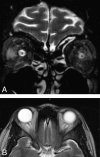MR imaging of papilledema and visual pathways: effects of increased intracranial pressure and pathophysiologic mechanisms
- PMID: 22422187
- PMCID: PMC7964659
- DOI: 10.3174/ajnr.A3022
MR imaging of papilledema and visual pathways: effects of increased intracranial pressure and pathophysiologic mechanisms
Abstract
Papilledema, defined as swelling of the optic disc, frequently occurs in the setting of increased ICP and in a variety of medical conditions, including pseudotumor cerebri, sinus thrombosis, intracerebral hemorrhage, frontal lobe neoplasms, and Chiari malformation. Noninvasive imaging of the ON is possible by using MR imaging, with a variety of findings occurring in the setting of papilledema, including flattening of the posterior sclera, protrusion of the optic disc, widening of the ONS, and tortuosity of the ON. Early recognition of papilledema and elevated ICP is of paramount importance for ensuring restoration of vision. Newer advanced MR imaging techniques such as fMRI and DTI may prove useful in the future to assess the potential effects of papilledema on retinal and visual pathway integrity.
Figures




References
-
- Killer HE, Jaggi GP, Miller NR. Papilledema revisited: is its pathophysiology really understood? Clin Experiment Ophthalmol 2009;37:444–47 - PubMed
-
- White LH. Papilledema of ototic origin. Arch Otolaryngol 1925;2:371–78
-
- Hansen HC, Helmke K. Validation of the optic nerve sheath response to changing cerebrospinal fluid pressure: ultrasound findings during intrathecal infusion tests. J Neurosurg 1997;87:34–40 - PubMed
-
- Watanabe A, Kinouchi H, Horikoshi T, et al. . Effect of intracranial pressure on the diameter of the optic nerve sheath. J Neurosurg 2008;109:255–58 - PubMed
Publication types
MeSH terms
LinkOut - more resources
Full Text Sources
Medical
Miscellaneous
